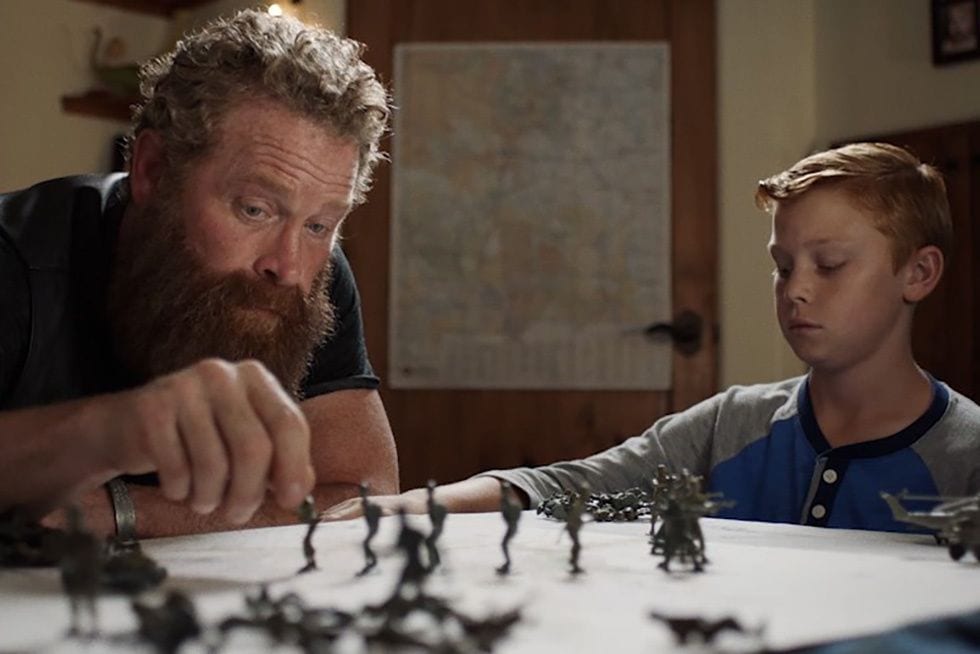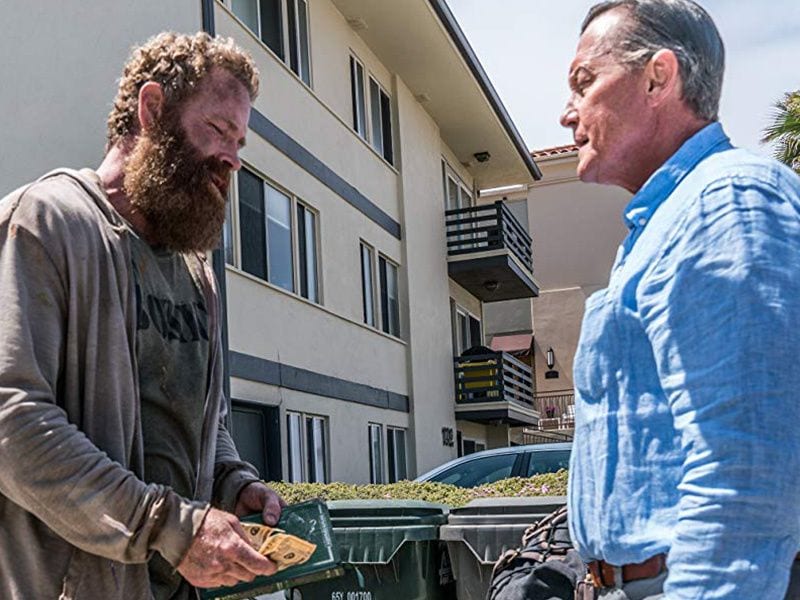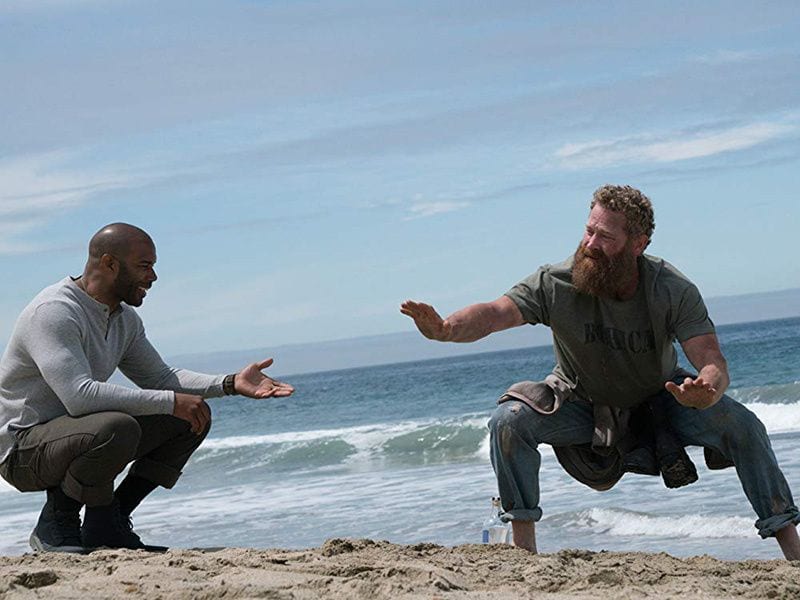
SGT. Will Gardner (2019) is Max Martini’s second film as writer-director, a two decade long pause following 1999’s Desert Son. Martini, who has appeared in front of the camera across film and television since the ’80s, plays here the title character also known as Ghost, an Iraq war veteran suffering from Traumatic Brain Injury. Setting out on a road trip, he sets his hopes on reconnecting with his young son and former wife. On his journey, he continues to be haunted by flashbacks to the war and the guilt of a friend and fellow soldiers death under his command.
While Martini has set out to tell a story that can help foster a greater understanding of Post Traumatic Stress Syndrome (PTSD), SGT. Will Gardner will take a financial step to both support Veterans in need of medical care and also to help prevent homelessness amongst Veterans. A percentage of the proceeds from the film will be donated to three charities: Higher Ground, Warrior’s Heart and the Gary Sinise Foundation.
In conversation with PopMatters, Martini reflects on the use of the camera to merge the visuals of his road movie with the panoramic western landscape of John Ford, while staying true to an intimate of a story of healing. He also discusses the decision to donate a percentage of the proceeds to charity and the potential social interaction of cinema as a medium.
Was there an inspirational or defining moment that led you into a creative career?
My father was born in Rome and was a sculptor. So I grew up in and around his studios and foundries, and the space was always creative. Then he and my mother separated, and she remarried an actor, director, writer, producer named Stuart Margolin. When I was younger he would throw me into roles. He would say: “Hey run over here and say this,” and so I had some experience with the entertainment industry early on.
When I finally went to college however, I got my degree in fine arts and I had every intention of painting and sculpting. And then [laughs], to pay off my art degree I got back into acting, and I never turned back. From college onwards I have probably been working as an actor professionally.
In terms of one defining moment, I think I knew that I wanted to do something creative. After college it was really a matter of which direction I could go and make money to support myself quite honestly, and it just turned out to be acting. I would have been happy to do my art work; either, or.
But that said, now having made this film, I’m branching into other aspects of filmmaking, and I felt for the first time I really got to utilise my art degree as a director, because you’re creating and setting the tone and look of the film with the cinematographer, and that’s a collaboration. You are involved in all aspects of the design, and so I felt like I was actually using little pockets of creativity that I hadn’t accessed since my early days in art school, and so that was nice.

There are moments in the film when the camera opens up the world in a romantic way, yet in other moments the camera hones in on the intimate aspects of the characters’ lives. What are your thoughts on the camera as a tool to capture your intent as a storyteller, and also as a means of communication with the audience?
Yeah, it’s an amazing tool and for me the camera was going to be my number one tool to use, but also in conjunction with the music. I felt the music was very important for the film, and as an actor, for a lot of the story, too,because so much of the struggle of these characters is they’re looking for something, some sort of validation and love, some missing link in their life, and there’s a lot of internal struggle. For instance, my character wants to reinvent his relationship with his son, and my son for all intent and purposes has not been able to meet his father. He maybe remembers him from photographs and so to capture that internal struggle I have to be in tight, on closer lenses, and a lot of the movie therefore plays in close-ups.
I wanted to do these big epic John Ford type western shots for the road and tell the visual story of America. In doing that we used drones and we had all kinds of gadgetry to assist us in telling that visual story, but in terms of the characters, I wanted to stay in quite close and see what was happening internally. And then my very good friend Jay DeMarcus, who is one of the three members of Rascal Flatts, a hugely popular country band, he scored the film and just did an incredible job; the music is very powerful.
This being my first directing job, what was fascinating to me was how much those layers add to the film in post-production. Everything from visual effects to the music and the colour correction, you can change and add so much. I really found that to be creatively satisfying and inspired, and also just so interesting that I had been in this industry for so long, and never been a part of that process.
I can’t recall which filmmaker remarked to me that you are writing in the editing stage, but I do recall Pablo Larraín telling me that you discover the film in the final cut. Would you agree that the filmmaking process is a journey of discovery?
I would entirely. In fact one of the most relieving moments that I had on this entire journey, which from the first word on screen to now was probably a decade, was actually sitting down with my editor. He was cutting the movie while we were filming and he would send snippets of scenes. We didn’t get to dive into it much, but at least we got to see that things were working. But when we finally sat down to watch his assembly, it was such a relief to see that the whole movie worked.
One of the challenges in our editing process was that at the end of the day our movie was about two and a half hours or so, and we had to cut out half an hour of story, which was very difficult. With this film in particular, because he’s on this road trip, it was hard to trim down those little segments. You either had to remove one entirely or it’s called “trimming fat”, and we did that forever.
But another element of the [editing] process is that you can change and make performances better, and create little moments that aren’t necessarily there. The movie absolutely comes alive in that period of time that you are cutting, and luckily we had a terrific editor in Tim Silano.
When we think of the ghost story, we think of the supernatural, but there’s also the human ghost story, which SGT. Will Gardner embodies: characters dealing with past experiences and memories that are source of angst.
One of the elements of Will Gardner’s healing is to lay to rest this memory of his fallen comrade, and also the survivors guilt that he’s carrying. Having been responsible for his best friends death, I wanted the memory or the ghost to facilitate his healing, and to show onscreen how you take something that is so haunting and so debilitating, and turn it around and make it work for you.
One of the through-lines in this film is that if our character Will Gardner/Ghost can heal himself, then he can heal others — other veterans and injured service people — because they have walked the same walk, they talk the same talk, and he is a survivor of these conditions. In writing this story I was a little apprehensive about bringing the element of a friend onscreen and into the picture who wasn’t really there. I think I found a way to make it work, and his purpose is to facilitate the healing.
It is not necessarily possible for us to identify with Will Gardner, to fully understand his pain because not many of us can begin to comprehend the experience of combat. Returning to the point in our discussion of the camera being in tight, while there is a disconnect with the character, the use of the camera helps to diminish that and forge a connection.
Absolutely, and one of the challenges in making this film is to also bring the experience that these veterans are having post-combat to screen in a way that educates. Ultimately, what I’m trying to do is inspire people to support these charities and private foundations that are making up for where the Veterans’ Administration is failing, and in trying to recruit people to do so, they have to understand what these soldiers are facing.
In my movie we primarily address three things: The homeless Veteran crisis here in America; traumatic brain injuries, which are tissue and bodily injuries, and PTS, which is an emotional injury. In PTS, which so many soldiers are suffering from, to capture that you have to be inside of the minds and emotions of these characters, and it’s hard to tell that story in a wide shot.
Storytelling is not only about entertainment, but is capable of serving a greater purpose. While a story can help us to engage with ourselves and our world, donating a percentage of profits for SGT. Will Gardner supports the idea that cinema can serve a more integral role in our society.
Well, I had a decision to make early on, which was when I was doing the research for this. I spoke to a lot of people who said: “Look, you have to address Veteran suicide… You have to address this or that… You have to be more heavy handed.” So the choice for me was to either make a documentary, and if I took that pathway I could be a little bit more heavy handed, or make a movie that not only carried this social statement, or this effort to maintain a level of awareness, but was also entertaining.
Actually, going even back further, when I decided to make this film I thought this could be a little piece of service to my country. I didn’t serve in the armed forces, I went a complete opposite direction. But it is service and film is such a powerful tool, and as an actor I have reached out to a broad audience, and in this medium it could be very powerful in helping to create change. Like I said, inspiring people to give back to the assistance of the Veteran community. I think it’s amazing and to my knowledge I don’t know that there has been a movie that has given back to charity, and especially such a large portion of the profits.
We are giving thirty percent of the film to three charities that receive ten percent each, and you know it’s a big chunk of the film. I don’t know if I’m pioneering the way here, but I think it will definitely demonstrate to people another use for the medium.
Filmmaker Christoph Behl remarked to me: “You are evolving, and after the film, you are not the same person as you were before.” Do you perceive there to be a transformative aspect to the creative process for you personally?
The change for me is going to be evident once we get into the profit sharing with these charities. The intention that I had initially to help the Veteran community was very strong, but I feel like every time you do good, you grow a little bit more, and so I’m anticipating that happening once we make a spectacle of giving back. Creatively, I grew so much on this film, and any sort of fear or hesitation that I had to get in front of and behind the camera on the same project went away once I saw the editor’s first assembly. So I grew creatively, but I also grew as a person, and the success of this movie is going to come with giving back; once that happens I think I’ll be anticipating quite a change in my heart.
***
SGT. Will Gardner is released theatrically and on VOD, January 11 2019.



